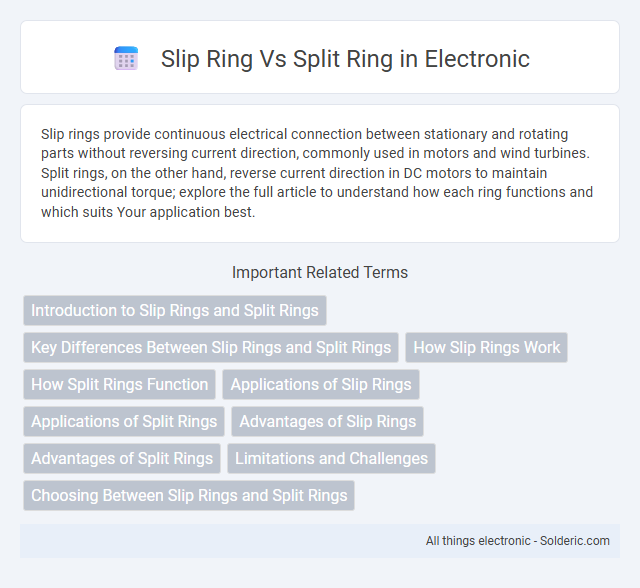Slip rings provide continuous electrical connection between stationary and rotating parts without reversing current direction, commonly used in motors and wind turbines. Split rings, on the other hand, reverse current direction in DC motors to maintain unidirectional torque; explore the full article to understand how each ring functions and which suits Your application best.
Comparison Table
| Feature | Slip Ring | Split Ring |
|---|---|---|
| Definition | Electromechanical device allowing transmission of power or signals from a stationary to a rotating structure. | Commutator type used in DC machines to reverse current direction in the armature windings. |
| Structure | Continuous ring(s) with brushes sliding over for contact. | Segmented ring with insulated sections separated by gaps. |
| Function | Transfers electrical signals or power maintaining continuous contact. | Reverses armature current to maintain unidirectional torque in DC motors. |
| Applications | Wind turbines, rotary sensors, electrical generators needing slip contacts. | DC motors, DC generators requiring commutation. |
| Current Type | AC and DC compatible. | Primarily DC. |
| Contact Type | Sliding brushes on continuous rings. | Sliding brushes on segmented rings. |
| Maintenance | Lower wear due to continuous rings, moderate maintenance. | Higher wear due to sparking, frequent maintenance. |
| Noise and Sparking | Minimal sparking, smooth operation. | Produces sparking during commutation, noisier. |
Introduction to Slip Rings and Split Rings
Slip rings and split rings are essential rotary electrical contacts used to transfer power and signals between stationary and rotating parts in machinery. Slip rings enable continuous rotation by maintaining an electrical connection through conductive rings and brushes, commonly found in wind turbines and electric motors. Split rings, also known as commutators, reverse current direction in DC machines to ensure unidirectional torque, crucial in applications like universal motors and certain electrical generators.
Key Differences Between Slip Rings and Split Rings
Slip rings provide continuous electrical connection in rotating systems, allowing transmission of power and signals without interruption, whereas split rings function mainly as commutators in DC machines to reverse current direction. Slip rings feature a complete ring and stationary brushes, enabling smooth rotation, while split rings are segmented rings that open and close circuits with each rotation. The primary difference lies in application: slip rings support AC signals and power transfer, while split rings facilitate current reversal in DC motor armatures.
How Slip Rings Work
Slip rings transmit electrical power and signals between stationary and rotating components by maintaining continuous electrical contact through conductive rings and brushes. They allow for unidirectional or bidirectional rotation without tangling wires, commonly used in wind turbines, electric motors, and rotary sensors. Unlike split rings, slip rings enable unlimited rotation while ensuring reliable conductivity through soft metal brushes.
How Split Rings Function
Split rings function as a crucial component in electrical machines by reversing the current direction in the coil windings, enabling continuous rotation without tangling wires. Unlike slip rings, split rings are segmented and insulated to intermittently connect and disconnect the coil from the external circuit, ensuring the torque produced maintains a consistent rotational direction. Their design is essential in converting alternating current induced in the coil into direct current output in devices like DC motors and generators.
Applications of Slip Rings
Slip rings are essential in applications requiring continuous rotation with power and signal transmission, such as wind turbines, robotics, medical imaging equipment, and rotary tables. They enable uninterrupted electrical connections in rotating systems like radar antennas and electric generators. Unlike split rings, slip rings support both AC and DC currents, making them ideal for complex machinery demanding reliable, high-speed data and power transfer.
Applications of Split Rings
Split rings are primarily used in electrical machines such as DC motors and generators to reverse the direction of current in the armature windings, enabling continuous rotation. These rings facilitate the commutation process, ensuring efficient energy conversion in automotive starters, electric trains, and small household appliances. Their application is crucial in systems requiring regular current reversal to maintain torque and operational stability.
Advantages of Slip Rings
Slip rings offer continuous rotation without electrical interruption, making them ideal for applications requiring 360-degree motion, such as wind turbines and robotics. Your system benefits from reduced wear and longer operational life compared to split rings, which rely on brushes and commutators prone to friction and sparking. Enhanced signal integrity and the ability to transmit power, data, or control signals simultaneously further distinguish slip rings as the superior choice in dynamic electrical connections.
Advantages of Split Rings
Split rings offer improved electrical contact stability and reduced wear compared to slip rings, making them ideal for applications requiring consistent current flow in rotating machinery. Their design minimizes arcing and maintenance needs, enhancing durability and performance in devices like DC motors and generators. You will benefit from their reliability and efficiency in systems demanding continuous rotation with reliable electrical conduction.
Limitations and Challenges
Slip rings often face limitations such as limited current capacity, wear and tear from continuous physical contact, and signal noise interference. Split rings, commonly used in simple DC motors, can cause sparking and reduced efficiency at high speeds due to commutator brush wear. Understanding these challenges helps you select the appropriate rotary electrical interface for your specific application requirements.
Choosing Between Slip Rings and Split Rings
When choosing between slip rings and split rings, consider the type of electrical connection and the mechanical requirements of your application. Slip rings provide continuous rotation with uninterrupted electrical contact, ideal for transmitting power and signals in rotating equipment. Split rings, often used in commutators, reverse current flow in DC motors by switching connections every half turn, making them suitable for specific motor designs but less effective for continuous rotation systems.
slip ring vs split ring Infographic

 solderic.com
solderic.com